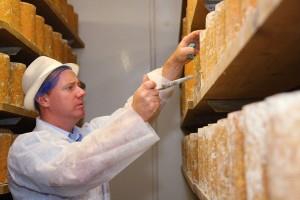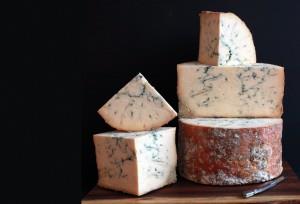The festive season is here - and as an avid cheese fiend I thought there was no better time to find out what's been happening at Colston Bassett Dairy, producer of the world-famous Stilton Cheese. The dairy, based in the Vale of Belvoir, has scooped a string of titles at this year's World Cheese Awards building on last year's success. We caught up with manager Billy Kevan to find out what makes Stilton so special...
How long has Colston Bassett been producing its famous Stilton cheese?
Established in 1913, Colston Bassett was the idea of the village doctor Dr William Windley. He suggested that local farmers set up a co-operative making cheese; this co-operative still operates under the same rules today. I have worked at Colston Bassett Dairy since 1999 and it was a privilege to participate in the 100th anniversary celebrations last year. The Dairy remains a very important part of our community so it was great for everyone to be involved in the centenary.
What goes into making your Stilton cheese?
We are very proud of our heritage and remain true to the traditional methods of  making Stilton. The milk we’re supplied is delivered to us from four local farms all located within a 1.5-mile radius of the Dairy in the Vale of Belvoir. Our milk is pasteurised then cooled to cheese making temperature where a live starter culture, blue mould (Penicillium Roqueforti) and an enzyme is added.
All the steps in our cheese making processes are undertaken by hand – from mixing the milk in our cheese vats, cutting of the curds, hand ladeling, milling, salting and mixing, through to filling the hoops (cheese moulds).
The cheese is allowed to drain in the hoops for a few days before being removed; the surface of the cheese is then smoothed to stop oxygen activating the blue spores too early. Every cheese is turned regularly by hand throughout the entire process.
As the cheese matures we introduce oxygen, which allows the blue veining associated with Stilton Cheese to develop. The cheese will be graded regularly until it is deemed suitable for sale.
Every cheese requires around 72 litres of milk to produce one 7.5kg Stilton cheese and as you can see it is a very labour intensive process.”
How long does it take to mature and become ready to eat?
Cheese making is an intuitive art form! There are many variables that can affect how long the process takes – temperature and humidity are two key factors. We have to adapt to these changing circumstances and respond accordingly. In broad terms, Stilton is usually ready to be eaten 10 – 12 weeks from when we pasteurise the milk and Shropshire Blue is usually eight to ten weeks.
How many other cheese makers were you competing against at the World Cheese Awards 2014?
There were almost 2,600 cheeses from 33 countries entered into the World Cheese Awards so we were delighted to win golds for both our cheeses. 2014 has been a brilliant year in terms of awards, we also won two Supreme Champion titles at both the International Cheese Awards and at the Great Yorkshire Show. To repeatedly achieve such results is testament to our high standards.
In your opinion, what’s the best way to enjoy Stilton Cheese?
I am something of a purist at heart. Colston Bassett Stilton has such a distinctive flavour
making Stilton. The milk we’re supplied is delivered to us from four local farms all located within a 1.5-mile radius of the Dairy in the Vale of Belvoir. Our milk is pasteurised then cooled to cheese making temperature where a live starter culture, blue mould (Penicillium Roqueforti) and an enzyme is added.
All the steps in our cheese making processes are undertaken by hand – from mixing the milk in our cheese vats, cutting of the curds, hand ladeling, milling, salting and mixing, through to filling the hoops (cheese moulds).
The cheese is allowed to drain in the hoops for a few days before being removed; the surface of the cheese is then smoothed to stop oxygen activating the blue spores too early. Every cheese is turned regularly by hand throughout the entire process.
As the cheese matures we introduce oxygen, which allows the blue veining associated with Stilton Cheese to develop. The cheese will be graded regularly until it is deemed suitable for sale.
Every cheese requires around 72 litres of milk to produce one 7.5kg Stilton cheese and as you can see it is a very labour intensive process.”
How long does it take to mature and become ready to eat?
Cheese making is an intuitive art form! There are many variables that can affect how long the process takes – temperature and humidity are two key factors. We have to adapt to these changing circumstances and respond accordingly. In broad terms, Stilton is usually ready to be eaten 10 – 12 weeks from when we pasteurise the milk and Shropshire Blue is usually eight to ten weeks.
How many other cheese makers were you competing against at the World Cheese Awards 2014?
There were almost 2,600 cheeses from 33 countries entered into the World Cheese Awards so we were delighted to win golds for both our cheeses. 2014 has been a brilliant year in terms of awards, we also won two Supreme Champion titles at both the International Cheese Awards and at the Great Yorkshire Show. To repeatedly achieve such results is testament to our high standards.
In your opinion, what’s the best way to enjoy Stilton Cheese?
I am something of a purist at heart. Colston Bassett Stilton has such a distinctive flavour  that I love the simplicity of spreading my Stilton onto fresh white crusty bread – it really does justice to the taste.
I recently attended a dinner celebrating our cheeses that was hosted by the Michelin starred chef, Nigel Haworth at the Northcote – four of the five courses featured Colston Bassett Stilton or Shropshire Blue. It was an incredibly innovative menu and demonstrated that Stilton is also a very versatile ingredient.
Are there any exciting new cheeses in the pipeline for 2015 at Colston Bassett?
New cheeses are not for us. We make two exceptional cheeses that win awards year after year. The satisfaction I have is from being able to deliver that consistency again and again. As dairy manager at Colston Bassett dairy and I like to concentrate to producing one of the best cheeses in the world; there isn’t much time for anything else.
If you would like more information on Colston Bassett Dairy visit the website.
that I love the simplicity of spreading my Stilton onto fresh white crusty bread – it really does justice to the taste.
I recently attended a dinner celebrating our cheeses that was hosted by the Michelin starred chef, Nigel Haworth at the Northcote – four of the five courses featured Colston Bassett Stilton or Shropshire Blue. It was an incredibly innovative menu and demonstrated that Stilton is also a very versatile ingredient.
Are there any exciting new cheeses in the pipeline for 2015 at Colston Bassett?
New cheeses are not for us. We make two exceptional cheeses that win awards year after year. The satisfaction I have is from being able to deliver that consistency again and again. As dairy manager at Colston Bassett dairy and I like to concentrate to producing one of the best cheeses in the world; there isn’t much time for anything else.
If you would like more information on Colston Bassett Dairy visit the website.
 making Stilton. The milk we’re supplied is delivered to us from four local farms all located within a 1.5-mile radius of the Dairy in the Vale of Belvoir. Our milk is pasteurised then cooled to cheese making temperature where a live starter culture, blue mould (Penicillium Roqueforti) and an enzyme is added.
All the steps in our cheese making processes are undertaken by hand – from mixing the milk in our cheese vats, cutting of the curds, hand ladeling, milling, salting and mixing, through to filling the hoops (cheese moulds).
The cheese is allowed to drain in the hoops for a few days before being removed; the surface of the cheese is then smoothed to stop oxygen activating the blue spores too early. Every cheese is turned regularly by hand throughout the entire process.
As the cheese matures we introduce oxygen, which allows the blue veining associated with Stilton Cheese to develop. The cheese will be graded regularly until it is deemed suitable for sale.
Every cheese requires around 72 litres of milk to produce one 7.5kg Stilton cheese and as you can see it is a very labour intensive process.”
How long does it take to mature and become ready to eat?
Cheese making is an intuitive art form! There are many variables that can affect how long the process takes – temperature and humidity are two key factors. We have to adapt to these changing circumstances and respond accordingly. In broad terms, Stilton is usually ready to be eaten 10 – 12 weeks from when we pasteurise the milk and Shropshire Blue is usually eight to ten weeks.
How many other cheese makers were you competing against at the World Cheese Awards 2014?
There were almost 2,600 cheeses from 33 countries entered into the World Cheese Awards so we were delighted to win golds for both our cheeses. 2014 has been a brilliant year in terms of awards, we also won two Supreme Champion titles at both the International Cheese Awards and at the Great Yorkshire Show. To repeatedly achieve such results is testament to our high standards.
In your opinion, what’s the best way to enjoy Stilton Cheese?
I am something of a purist at heart. Colston Bassett Stilton has such a distinctive flavour
making Stilton. The milk we’re supplied is delivered to us from four local farms all located within a 1.5-mile radius of the Dairy in the Vale of Belvoir. Our milk is pasteurised then cooled to cheese making temperature where a live starter culture, blue mould (Penicillium Roqueforti) and an enzyme is added.
All the steps in our cheese making processes are undertaken by hand – from mixing the milk in our cheese vats, cutting of the curds, hand ladeling, milling, salting and mixing, through to filling the hoops (cheese moulds).
The cheese is allowed to drain in the hoops for a few days before being removed; the surface of the cheese is then smoothed to stop oxygen activating the blue spores too early. Every cheese is turned regularly by hand throughout the entire process.
As the cheese matures we introduce oxygen, which allows the blue veining associated with Stilton Cheese to develop. The cheese will be graded regularly until it is deemed suitable for sale.
Every cheese requires around 72 litres of milk to produce one 7.5kg Stilton cheese and as you can see it is a very labour intensive process.”
How long does it take to mature and become ready to eat?
Cheese making is an intuitive art form! There are many variables that can affect how long the process takes – temperature and humidity are two key factors. We have to adapt to these changing circumstances and respond accordingly. In broad terms, Stilton is usually ready to be eaten 10 – 12 weeks from when we pasteurise the milk and Shropshire Blue is usually eight to ten weeks.
How many other cheese makers were you competing against at the World Cheese Awards 2014?
There were almost 2,600 cheeses from 33 countries entered into the World Cheese Awards so we were delighted to win golds for both our cheeses. 2014 has been a brilliant year in terms of awards, we also won two Supreme Champion titles at both the International Cheese Awards and at the Great Yorkshire Show. To repeatedly achieve such results is testament to our high standards.
In your opinion, what’s the best way to enjoy Stilton Cheese?
I am something of a purist at heart. Colston Bassett Stilton has such a distinctive flavour  that I love the simplicity of spreading my Stilton onto fresh white crusty bread – it really does justice to the taste.
I recently attended a dinner celebrating our cheeses that was hosted by the Michelin starred chef, Nigel Haworth at the Northcote – four of the five courses featured Colston Bassett Stilton or Shropshire Blue. It was an incredibly innovative menu and demonstrated that Stilton is also a very versatile ingredient.
Are there any exciting new cheeses in the pipeline for 2015 at Colston Bassett?
New cheeses are not for us. We make two exceptional cheeses that win awards year after year. The satisfaction I have is from being able to deliver that consistency again and again. As dairy manager at Colston Bassett dairy and I like to concentrate to producing one of the best cheeses in the world; there isn’t much time for anything else.
If you would like more information on Colston Bassett Dairy visit the website.
that I love the simplicity of spreading my Stilton onto fresh white crusty bread – it really does justice to the taste.
I recently attended a dinner celebrating our cheeses that was hosted by the Michelin starred chef, Nigel Haworth at the Northcote – four of the five courses featured Colston Bassett Stilton or Shropshire Blue. It was an incredibly innovative menu and demonstrated that Stilton is also a very versatile ingredient.
Are there any exciting new cheeses in the pipeline for 2015 at Colston Bassett?
New cheeses are not for us. We make two exceptional cheeses that win awards year after year. The satisfaction I have is from being able to deliver that consistency again and again. As dairy manager at Colston Bassett dairy and I like to concentrate to producing one of the best cheeses in the world; there isn’t much time for anything else.
If you would like more information on Colston Bassett Dairy visit the website.
Related
0 Comments
Comments
Comments are disabled for this post.

 to add an item to your Itinerary basket.
to add an item to your Itinerary basket.










